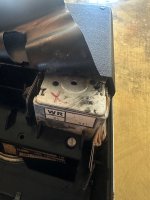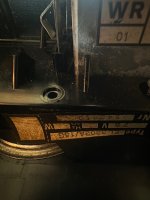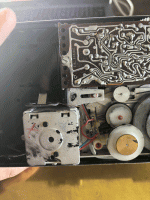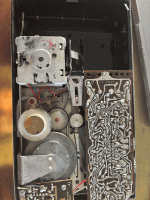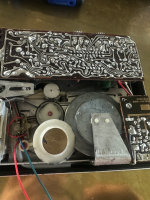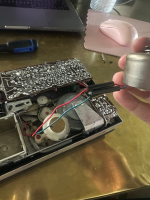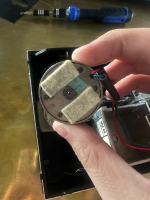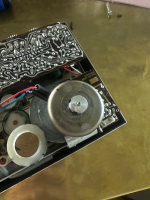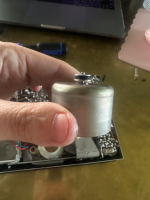Hi there,
I have a Phillips Cassette Player with a broken motor. I am looking for somewhere in the United States or Europe to get this fixed.
Type: EL 3302A/15G
Voltage: 7.5V
Frequency: 50/60 Hz
Manufacturer: Philips
Motor markings: WR 01 941
I believe that the motor I am looking for is a small DC motor, likely a 7.5V brushed type used to drive the capstan and reels.
Does anyone have any advice to where I can find one of these and/or get this fixed? I am located in California, but again, can send it anywhere.
Thank you.
I have a Phillips Cassette Player with a broken motor. I am looking for somewhere in the United States or Europe to get this fixed.
Type: EL 3302A/15G
Voltage: 7.5V
Frequency: 50/60 Hz
Manufacturer: Philips
Motor markings: WR 01 941
I believe that the motor I am looking for is a small DC motor, likely a 7.5V brushed type used to drive the capstan and reels.
Does anyone have any advice to where I can find one of these and/or get this fixed? I am located in California, but again, can send it anywhere.
Thank you.
Attachments
You could try asking if someone has a second-hand motor on this forum:
https://www.transistorforum.nl/forum/
It's in Dutch, but threads in other languages are allowed.
https://www.transistorforum.nl/forum/
It's in Dutch, but threads in other languages are allowed.
@CP2025 The motor runs on 3-5V. The speed regulator needs some headroom.
What happens when you power-up the recorder and press play, wind or rewind? Is the motor powered on too? There are some switches in the circuit. Make shure the motor gets what it needs before attempting to fix it.
In this recorder the motor rotation direction ist reverted for rew. Modern capstan motors employed in recorders are optimized for one direction of rotation so you'll have to find an older one.
You can dismantle the motor and check collector and brushes.
What happens when you power-up the recorder and press play, wind or rewind? Is the motor powered on too? There are some switches in the circuit. Make shure the motor gets what it needs before attempting to fix it.
In this recorder the motor rotation direction ist reverted for rew. Modern capstan motors employed in recorders are optimized for one direction of rotation so you'll have to find an older one.
You can dismantle the motor and check collector and brushes.
I was asking because I could not see neither the motor pulley nor the shaft. Both are inside the housing. My fault.
Last edited:
Now you need the dimensions (diameter and lenght) of the motor and the shaft. And you can estimate the nominal speed of it. Should be between 1400 and 2000 rpm. Common cassette tape recorders use 2400 rpm motors but this one has a larger pulley.
That's ca. 32,5 mm diameter. Is 1,5 inch the overall shaft lenght?
I've ordered a motor for one of my restauration projects (not Philips but a east Europe replica) and will report about it.
I've ordered a motor for one of my restauration projects (not Philips but a east Europe replica) and will report about it.
Some of these motors have built-in centrifugal speed control. At least Philips turntable motors had. Can you disassemble this motor and check.
Once you disassembled the motor you can check the collector and the brushes. And the centrifugal contacts if they are present. See, these motors were designed and used in a time when they were built to last. It is unlikely the windings have opened like with any Chines motor now.
Can you describe the fault. Is it stuck (easy to solve), is it open (see above), shorted (replace).
When it is centrifugally regulated you need an exact replacement. When it is generic, you have a much broader choice mainly limited by size.
Once you disassembled the motor you can check the collector and the brushes. And the centrifugal contacts if they are present. See, these motors were designed and used in a time when they were built to last. It is unlikely the windings have opened like with any Chines motor now.
Can you describe the fault. Is it stuck (easy to solve), is it open (see above), shorted (replace).
When it is centrifugally regulated you need an exact replacement. When it is generic, you have a much broader choice mainly limited by size.
It has electronic speed control, according to schematics and service manual.
One can see the control board in the images above.
https://www.vintage-radio.net/forum...318321c3ed0a&attachmentid=285685&d=1695832565
(Other schematics and service manuals are close, Ge pnp BJTs instead of Si npn..)
One can see the control board in the images above.
https://www.vintage-radio.net/forum...318321c3ed0a&attachmentid=285685&d=1695832565
(Other schematics and service manuals are close, Ge pnp BJTs instead of Si npn..)
Last edited:
- Home
- Source & Line
- Analogue Source
- Phillips Cassette Player
